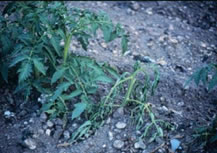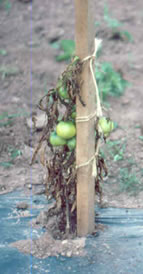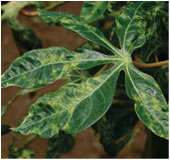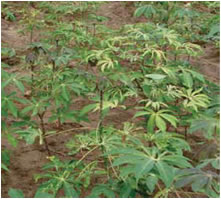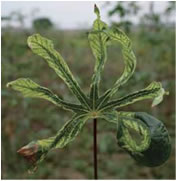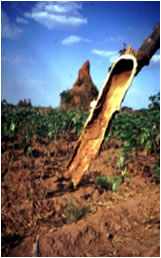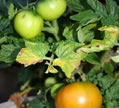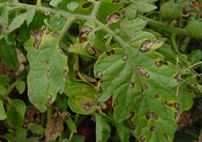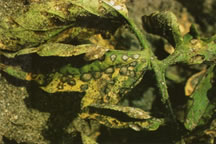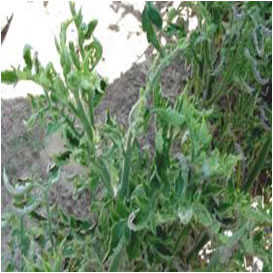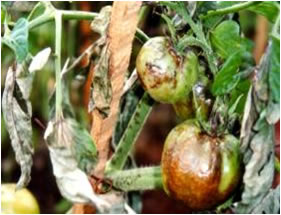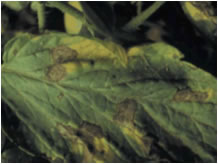
 |
 |
 |
| Planting and vegetative growth stage |
| Parts affected | Symptoms |
Management |
Image |
| Leaves and petiole | •Causes death of young seedlings in nursery. • After germination, rotting starts from the basal part of the seedling, complete rotting of the radicle and plumule and toppling of infected seedlings. • Infected tissues appear soft and water soaked. |
• Water stagnation should be avoided. • Treat the seeds with Trichoderma viride 4 g/kg or Pseudomonas fluorescens 10 g /kg of seed 24 hours before sowing. • Apply Pseudomonas fluorescens as soil application @ 2.5 kg/ha mixed with 50 kg of FYM. • Drench with Copper oxychloride at 2.5 g/lit at 4 lit/sq.m. |
|
| Diseases | Symptoms |
Management |
Image |
Mosaic disease: Vector white fly Affected plant stages: Seedling to reproductive stages
|
• White or pale-yellow or pale-green spots on infected leaves.
|
Cultural method: • Use of cassava resistant varieties or diseased-free planting materials.
• Removal of infected plants
• Maintain field sanitation
Chemical method:
• Spray dimethoate ( 1.7 ml / lit ) to check the vectors. |
|
| Maturity and Harvesting stage |
| Insect Pest | Symptom of Damage |
Advisory |
Image |
| Stem and root feeders Termites |
• Termites chew and eat stem cuttings. • Affected stem cuttings grow poorly, die and rot. • In older Plants, termites chew and enter the stems. • This weakens the stems and causes them to break easily. • Termite damage occurs mostly in the dry season. |
• Sprinkle dust of carbaryl 10% or chlorpyrifos in the mounds prior to planting. | |
| Tapioca stem cutting destroyed by termites and Stem of a mature tapioca plant chewed off by termites (termite nest in background, center) | |||
|
| Vegetative and early fruiting stage |
| Parts affected | Symptoms |
Management |
Image |
| Panicles, leaves and stem | • Polyphagous and a major pest of tomato. • Young larvae feed on tender foliage; advanced stage larvae (4 th instars onwards) attack the fruits. • Larvae bore circular holes into immature fruit but do not fully enter them. • Large fruit are only partly damaged by larvae but they are invariably invaded later by fungi, bacteria and other pathogens that spoil the fruit completely. • Larvae move from one fruit to another and one caterpillar may damage between two to eight fruit. |
•Collection and destruction of damaged fruits and larvae. • Summer ploughing to expose and kill pupae in the soil • Grow simultaneously 40day old African marigold planted along with 25 day old tomato seedlings (1 : 16 rows) to attract adults for egg laying. • Set up pheromone traps at @12 / ha and change the lure once in 15 days to monitor the adult moth activity. • Release Trichogramma chilonis @ 50000/ha/week over a six week period, with the first release corresponding with either the initiation of flowering and on an economic threshold level of 4 to 6 moths caught per pheromone trap. • Spray NSKE 50g/l of water to kill early stage larvae • Set up 15 to 20 bird perches per ha to encourage predatory birds • Spray Ha NPV 1.5 × 10 12 POBs /ha adding jaggery 20g/lit as a phagostimulant. • Need based application of endosulfan 35 EC 2ml/lit or carbaryl 50WP 2g/ lit or quinalphos 2.5ml/ lit or Bacillus thuringiensis 2g/lit. |
 |
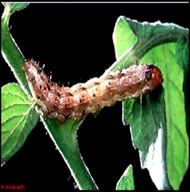 |
|||
| Parts affected | Symptoms |
Management |
Image |
| Panicles, leaves and stem | • Freshly hatched larvae feed gregariously on foliage, scrapping the leaves on the ventral surface at night. During severe infestations the entire crop may be defoliated. Larvae are also known to feed on young fruits | • Plough fields to exposes the pupae to predation • Flood the field to drown the hibernating larvae • Hand collect and destroy egg masses and young larvae on skeletonized leaves. • Hand pick larvae and kill them • Grow castor as a trap crop along the field border and irrigation channel to attract the egg-laying moths. • Set up pheromone traps @12 / ha to monitor adult activity and change the lure once in 15 days. • Spray Sl NPV1.5 ×10 12 POBs/ha in the early evening. • Need based application of endosulfan 35 EC 2ml/lit or carbaryl 50WP 2g/ lit or quinalphos 2.5ml/ lit or Bacillus thuringiensis 2g/lit in 400 lit of water. • Provide poison bait with carbaryl 1.25 kg, rice bran 12.5 kg, jaggery 1.25 kg and water 7.5 lit/ha. |
 |
| Parts affected | Symptoms |
Management |
Image |
| Leaves and stem | • Minute orange yellow apodous maggots mine epidermal layers of the leaves and cause serpentine mines that result in the drying and drooping of leaves. • The first larval stage of the leaf miner burrows into the mesophyll tissue. • The second stage also feeds in the mesophyll tissue. • The third stage larva concentrates its feeding towards the upper leaf surface. • When it matures the larva cuts a longitudinal slit in the leaf and leaves to pupate on the leaf surface or on the ground. • Damage caused by a single larva is minimal, however when large populations are present they are capable of destroying leaves and affecting the growth of plants. |
•Serpentine leaf miner can be controlled by spraying Neem Seed Kernel Extract 50 g/lit. | 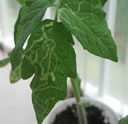 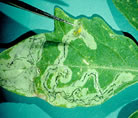 |
 |
| Parts affected | Symptoms |
Management |
Image |
| Leaves and stem | • Nymphs and adults suck the sap from the tender leaves. • The affected leaves become yellowish, wrinkle, curl downward and are ultimately shed. • The honeydew exuded by these insects favour the development of sooty mould. • Whitefly also act as vectors for leaf curl virus disease. |
• Install yellow sticky traps to attract the adult. 2. Spray Dichlorvos 76 WSC @ 1 ml/lit or Triazophos 40 EC 2 ml/lit or fish oil rosin soap 25 g/lit or Dimethoate 2 ml/lit or Methyl demeton 25 EC 2 ml/lit along with the wetting agent (Teepol@ 1 ml/lit) 3. Remove alternate weed host Abutilon indicum |
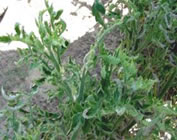
|
| Parts affected | Symptoms |
Management |
Image |
| Leaves and stem | • Due to the scraping by adult thrips, tender foliage becomes spotted, pale and silvery streaks appear on the affected plants. • Eggs, nymphs and adults may be found together at any time during the summer and produce many overlapping generations. • Besides feeding, thrips act as a disease vector and transmit tomato spotted wilt virus. |
•Install yellow sticky traps smeared with sticky substances to attract and kill insects. • Release first instar larvae of the green lace wing bug Chrysoperla carnea @10000/ha and encourage coccinellid predators. • Spray methyl dematon 25 EC 2ml/lit or dimethoate 30EC 2ml/lit or endosulfan 2ml/lit to control thrips. |
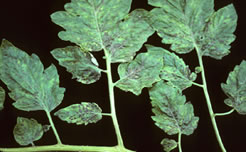 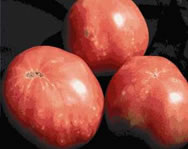 |
| Parts affected | Symptoms |
Management |
Image |
| Panicles, leaves and stem | Both adults and nymphs suck cell sap from the leaves and inject toxic saliva into plant tissues. Infested leaves show yellowing followed by crinkling and curling that leads to bronzing and hopper burn. Plants become stunted and may be killed in severe cases. |
Dimethoate 30EC 2ml/lit combined with NSKE 50g/lit of water. | 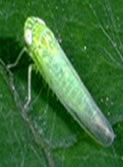 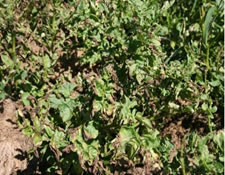 |
| Parts affected | Symptoms |
Management |
Image |
| Leaves and stem | • Both adults and grubs cause considerable damage to leaves by scrapping away chlorophyll from epidermal layers of leaves which become skeletonised and gradually dry up. • Adults are active fliers and move about from plant to plant. Larvae are stationary on the leaves and can occur in large numbers. |
•Collect and destroy damaged leaves and egg masses on leaves. • Shake the plants to dislodge larvae, pupae and adults in a pail of water containing kerosene early in the morning. • Spray carbaryl 50 WP 2g/lit or endosulfan 35EC 2ml/lit or malathion 50Ec 2ml/lit. |
 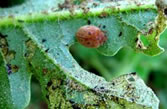 |
| Parts affected | Symptoms |
Management |
Image |
| •The first symptoms are numerous, small, water-soaked spots on leaves. • The spots are roughly circular with grey centers and dark margins and lack a yellow halo. • Dark specks, which are fruiting structures of the fungus, develop near the center of the spots. • Similar spots may occur on stems, blossoms, or fruit stems. Although fruit are not affected, defoliation of the plants renders the fruit susceptible to sunscald. • This organism lives in affected crop debris. |
•Leaf spot can be controlled by spraying Zineb or Mancozeb 2 g/lit. |
|
| Parts affected | Symptoms |
Management |
Image |
| leaves, stem and fruit | •Curling and puckering of the leaves as also blistering and shortening. • Stunted growth in affected plants • Presence of leafy out growths called "enations" on the under surface of leaves followed by mottling and vein clearing. • Complete or partial sterility |
• Removal and destruction of affected plants • Spray systemic insecticides like Methyl demeton or Dimethoate at 2 ml/lit. to kill the insect vector (whitefly). |
|
| Parts affected | Symptoms |
Management |
Image |
| Panicles, leaves and stem | •
It affects the foliage, stems and fruit of tomatoes. |
•Apply chlorothalonil (Bravo, Echo, and others), mancozeb (Manzate 75DF, Dithane DF, Penncozeb75DF, and Manex II), maneb (Maneb 75DF or Manex), and metiram (Polyram 80DF) in combination with triphenyltin hydroxide (Super Tin 80WP). |
 |
|
| Maturity fruiting stage |
| Parts affected | Symptoms |
Management |
Image |
| Panicles, leaves and stem | • Polyphagous and a major pest of tomato. • Young larvae feed on tender foliage; advanced stage larvae (4 th instars onwards) attack the fruits. • Larvae bore circular holes into immature fruit but do not fully enter them. • Large fruit are only partly damaged by larvae but they are invariably invaded later by fungi, bacteria and other pathogens that spoil the fruit completely. • Larvae move from one fruit to another and one caterpillar may damage between two to eight fruit. |
•Collection and destruction of damaged fruits and larvae. • Summer ploughing to expose and kill pupae in the soil • Grow simultaneously 40day old African marigold planted along with 25 day old tomato seedlings (1 : 16 rows) to attract adults for egg laying. • Set up pheromone traps at @12 / ha and change the lure once in 15 days to monitor the adult moth activity. • Release Trichogramma chilonis @ 50000/ha/week over a six week period, with the first release corresponding with either the initiation of flowering and on an economic threshold level of 4 to 6 moths caught per pheromone trap. • Spray NSKE 50g/l of water to kill early stage larvae • Set up 15 to 20 bird perches per ha to encourage predatory birds • Spray Ha NPV 1.5 × 10 12 POBs /ha adding jaggery 20g/lit as a phagostimulant. • Need based application of endosulfan 35 EC 2ml/lit or carbaryl 50WP 2g/ lit or quinalphos 2.5ml/ lit or Bacillus thuringiensis 2g/lit. |
 |
 |
|||
| Parts affected | Symptoms |
Management |
Image |
| Panicles, leaves and stem | •
It affects the foliage, stems and fruit of tomatoes. |
•Apply chlorothalonil (Bravo, Echo, and others), mancozeb (Manzate 75DF, Dithane DF, Penncozeb75DF, and Manex II), maneb (Maneb 75DF or Manex), and metiram (Polyram 80DF) in combination with triphenyltin hydroxide (Super Tin 80WP). |
 |
|
![]()
Focus Districts
Gallery

